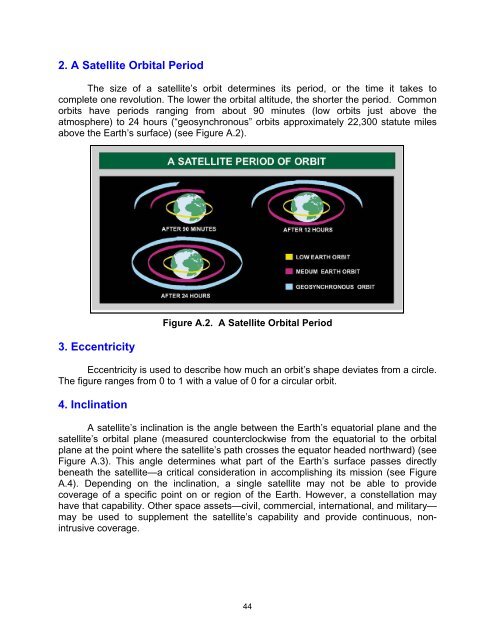Space Operations
Space Operations
Space Operations
You also want an ePaper? Increase the reach of your titles
YUMPU automatically turns print PDFs into web optimized ePapers that Google loves.
2. A Satellite Orbital Period<br />
The size of a satellite’s orbit determines its period, or the time it takes to<br />
complete one revolution. The lower the orbital altitude, the shorter the period. Common<br />
orbits have periods ranging from about 90 minutes (low orbits just above the<br />
atmosphere) to 24 hours (“geosynchronous” orbits approximately 22,300 statute miles<br />
above the Earth’s surface) (see Figure A.2).<br />
3. Eccentricity<br />
Figure A.2. A Satellite Orbital Period<br />
Eccentricity is used to describe how much an orbit’s shape deviates from a circle.<br />
The figure ranges from 0 to 1 with a value of 0 for a circular orbit.<br />
4. Inclination<br />
A satellite’s inclination is the angle between the Earth’s equatorial plane and the<br />
satellite’s orbital plane (measured counterclockwise from the equatorial to the orbital<br />
plane at the point where the satellite’s path crosses the equator headed northward) (see<br />
Figure A.3). This angle determines what part of the Earth’s surface passes directly<br />
beneath the satellite—a critical consideration in accomplishing its mission (see Figure<br />
A.4). Depending on the inclination, a single satellite may not be able to provide<br />
coverage of a specific point on or region of the Earth. However, a constellation may<br />
have that capability. Other space assets—civil, commercial, international, and military—<br />
may be used to supplement the satellite’s capability and provide continuous, nonintrusive<br />
coverage.<br />
44
















